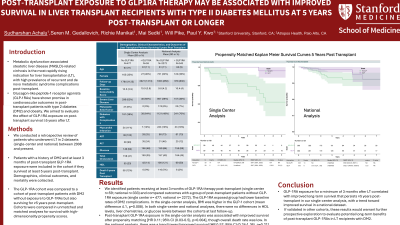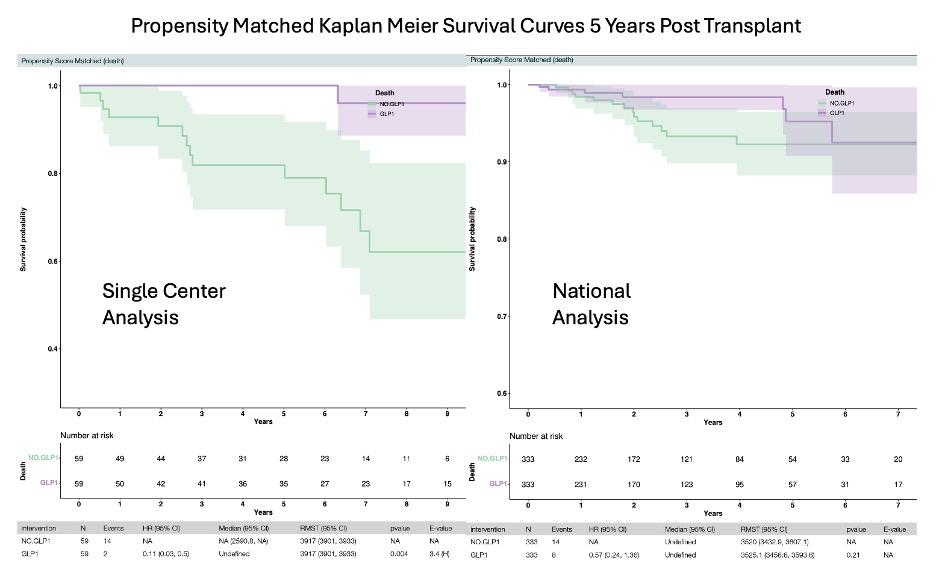Sunday Poster Session
Category: Liver
P1150 - Post-Transplant Exposure to GLP1RA Therapy May Be Associated With Improved Survival in Liver Transplant Recipients With Type II Diabetes Mellitus at 5 Years Post-Transplant Or Longer
Sunday, October 27, 2024
3:30 PM - 7:00 PM ET
Location: Exhibit Hall E

Has Audio
- SA
Sudharshan Achalu, BA
Stanford University
Palo Alto, CA
Presenting Author(s)
Sudharshan Achalu, BA1, Seren M. Gedallovich, MD2, Richie Manikat, MD2, Mai Sedki, MD, MPH2, Saurabh Gombar, MD3, Paul Y. Kwo, MD, FACG2
1Stanford University, Palo Alto, CA; 2Stanford University, Redwood City, CA; 3Atropos Health, Redwood City, CA
Introduction: Metabolic dysfunction-associated steatotic liver disease (MASLD)-related cirrhosis is the most rapidly rising indication for liver transplantation (LT), with high prevalence of recurrent and de novo metabolic syndrome complications post-transplant. Glucagon-like peptide-1 receptor agonists (GLP-1RAs) have shown promise in cardiovascular outcomes in post-transplant patients with type 2 diabetes (DM2) and obesity. We aimed to evaluate the effect of GLP-1RA exposure on post-transplant survival ≥5 years after LT.
Methods: We conducted a retrospective review of patients who underwent LT in 2 datasets (single-center and national) between 2008 and present. Patients with a history of DM2 and at least 3 months of post-transplant GLP-1RA exposure were included in the cohort if they survived at least 5 years post-transplant. Demographics, clinical outcomes, and mortality were collected. The GLP-1RA cohort was compared to a cohort of post-transplant patients with DM2 without exposure to GLP-1RAs but also surviving for ≥5 years post-transplant. Cohorts were compared in unmatched and matched analyses for survival with high-dimensionality propensity scores.
Results: We identified patients receiving at least 3 months of GLP-1RA therapy post-transplant (single center n=59; national n=333) and compared outcomes with a group of post-transplant patients without GLP-1RA exposure (single center n= 477; national n= 2272). The GLP-1RA exposed group had lower baseline rates of DM2 complications. In the single-center analysis, BMI was higher in the GLP-1 cohort (mean difference 4.1, p=0.008). In both single-center and national analyses, there were no differences in HDL levels, liver chemistries, or glucose levels between the cohorts at last follow-up. Post-transplant GLP-1RA exposure in the single-center analysis was associated with improved survival after propensity matching [HR 0.11; 95% CI (0.03-0.5), p=0.004], though overall death rate was low. In the national analysis, there was a trend toward improved survival [HR 0.57; 95% CI (0.24-1.36), p=0.21].
Discussion: GLP-1RA exposure for a minimum of 3 months after LT correlated with improved long-term survival that persists ≥5 years post-transplant in our single-center analysis, with a trend toward improved survival in a national dataset. If validated in other cohorts, these results would warrant further prospective exploration to evaluate potential long-term benefits of post-transplant GLP-1RAs in LT recipients with DM2.

Note: The table for this abstract can be viewed in the ePoster Gallery section of the ACG 2024 ePoster Site or in The American Journal of Gastroenterology's abstract supplement issue, both of which will be available starting October 27, 2024.
Disclosures:
Sudharshan Achalu, BA1, Seren M. Gedallovich, MD2, Richie Manikat, MD2, Mai Sedki, MD, MPH2, Saurabh Gombar, MD3, Paul Y. Kwo, MD, FACG2. P1150 - Post-Transplant Exposure to GLP1RA Therapy May Be Associated With Improved Survival in Liver Transplant Recipients With Type II Diabetes Mellitus at 5 Years Post-Transplant Or Longer, ACG 2024 Annual Scientific Meeting Abstracts. Philadelphia, PA: American College of Gastroenterology.
1Stanford University, Palo Alto, CA; 2Stanford University, Redwood City, CA; 3Atropos Health, Redwood City, CA
Introduction: Metabolic dysfunction-associated steatotic liver disease (MASLD)-related cirrhosis is the most rapidly rising indication for liver transplantation (LT), with high prevalence of recurrent and de novo metabolic syndrome complications post-transplant. Glucagon-like peptide-1 receptor agonists (GLP-1RAs) have shown promise in cardiovascular outcomes in post-transplant patients with type 2 diabetes (DM2) and obesity. We aimed to evaluate the effect of GLP-1RA exposure on post-transplant survival ≥5 years after LT.
Methods: We conducted a retrospective review of patients who underwent LT in 2 datasets (single-center and national) between 2008 and present. Patients with a history of DM2 and at least 3 months of post-transplant GLP-1RA exposure were included in the cohort if they survived at least 5 years post-transplant. Demographics, clinical outcomes, and mortality were collected. The GLP-1RA cohort was compared to a cohort of post-transplant patients with DM2 without exposure to GLP-1RAs but also surviving for ≥5 years post-transplant. Cohorts were compared in unmatched and matched analyses for survival with high-dimensionality propensity scores.
Results: We identified patients receiving at least 3 months of GLP-1RA therapy post-transplant (single center n=59; national n=333) and compared outcomes with a group of post-transplant patients without GLP-1RA exposure (single center n= 477; national n= 2272). The GLP-1RA exposed group had lower baseline rates of DM2 complications. In the single-center analysis, BMI was higher in the GLP-1 cohort (mean difference 4.1, p=0.008). In both single-center and national analyses, there were no differences in HDL levels, liver chemistries, or glucose levels between the cohorts at last follow-up. Post-transplant GLP-1RA exposure in the single-center analysis was associated with improved survival after propensity matching [HR 0.11; 95% CI (0.03-0.5), p=0.004], though overall death rate was low. In the national analysis, there was a trend toward improved survival [HR 0.57; 95% CI (0.24-1.36), p=0.21].
Discussion: GLP-1RA exposure for a minimum of 3 months after LT correlated with improved long-term survival that persists ≥5 years post-transplant in our single-center analysis, with a trend toward improved survival in a national dataset. If validated in other cohorts, these results would warrant further prospective exploration to evaluate potential long-term benefits of post-transplant GLP-1RAs in LT recipients with DM2.

Figure: Kaplan Meier Survival Curves for Single Center and National Analyses
Note: The table for this abstract can be viewed in the ePoster Gallery section of the ACG 2024 ePoster Site or in The American Journal of Gastroenterology's abstract supplement issue, both of which will be available starting October 27, 2024.
Disclosures:
Sudharshan Achalu indicated no relevant financial relationships.
Seren Gedallovich indicated no relevant financial relationships.
Richie Manikat indicated no relevant financial relationships.
Mai Sedki indicated no relevant financial relationships.
Saurabh Gombar indicated no relevant financial relationships.
Paul Kwo: Abbvie – Consultant. Aligos – Consultant. Altimmune – Grant/Research Support. Arrowhead – Grant/Research Support. Drug Farm – Consultant. Durect – Consultant, Stock Options. Generon – Consultant. Gilead – Consultant, Grant/Research Support. HepQuant – Consultant. Inventiva – Consultant. Madrigal – Grant/Research Support. Mallinckrodt – Consultant. Mirum – Consultant. Novo Nordisk – Consultant, Grant/Research Support. Salix – Grant/Research Support. Surrozen – Consultant. Target Registries – Grant/Research Support. Ultragenyx – Grant/Research Support.
Sudharshan Achalu, BA1, Seren M. Gedallovich, MD2, Richie Manikat, MD2, Mai Sedki, MD, MPH2, Saurabh Gombar, MD3, Paul Y. Kwo, MD, FACG2. P1150 - Post-Transplant Exposure to GLP1RA Therapy May Be Associated With Improved Survival in Liver Transplant Recipients With Type II Diabetes Mellitus at 5 Years Post-Transplant Or Longer, ACG 2024 Annual Scientific Meeting Abstracts. Philadelphia, PA: American College of Gastroenterology.
